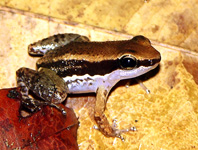Abstract
The bluespotted maskray, Neotrygon kuhlii (Müller & Henle, 1841), once thought to be widely distributed in the Indo-West Pacific, consists of a complex of several species and the type series consists of multiple species; its nomenclature is discussed. A lectotype and paralectotype are designated and the species rediagnosed based on the types and a fresh specimen from Honiara (Solomon Islands), near to the collection locality of the lectotype (Vanikoro, Solomon Islands). Molecular and morphological data provide confirmatory evidence that this maskray is distinct from some other regional forms. Three members of the complex from the Western Pacific identified in earlier studies are confirmed to be new species; Neotrygon australiae sp. nov. (Australia, New Guinea and eastern Indonesia), N. caeruleopunctata sp. nov. (Indian Ocean), and N. orientale sp. nov. (North-West Pacific). These species differ from each other and N. kuhlii in their adult size, anterior angle of the disc, number and distribution of blue spots on the dorsal disc, and other more subtle morphometric and meristic characters. Another largely plain-coloured Neotrygon, also currently misidentified as N. kuhlii, is sympatric with N. orientale sp. nov. in the South China Sea and off Taiwan. Neotrygon varidens (Garman) is resurrected as the valid name for this ray. A key is provided to species of the genus.
References
Borsa, P., Arlyza, I.S., Chen, W.J., Durand, J.D., Meekan, M.G. & Shen, K.N. (2013) Resurrection of New Caledonian maskray Neotrygon trigonoides (Myliobatoidei: Dasyatidae) from synonymy with N. kuhlii, based on cytochrome-oxidase I gene sequences and spotting patterns. Comptes Rendus Biologies, 336, 221–232.
Castelnau, F.L. (1873) Contribution to the ichthyology of Australia. Proceedings of the Zoological and Acclimatisation Society of Victoria, Melbourne, 2, 37–158.
Fowler, H.W. (1928) The fishes of Oceania. Memoirs of the Bernice P. Bishop Museum. No. 10, 540 pp.
Garman, S. (1885) Notes and descriptions taken from selachians in the U. S. National Museum. Proceedings of the United States National Museum, 8 (482), 39–44.
Garman, S. (1913) The Plagiostomia (sharks, skates, and rays). Memoirs of the Museum of Comparative Zoology, 36, 515 pp.
Holmes, B.H., Steinke, D. & Ward, R.D. (2009) Identification of shark and ray fins using DNA barcoding. Fisheries Research, 95, 280–288.
Last, P.R. (1987) New Australian fishes. Part 14. Two new species of Dasyatis (Dasyatididae). Memoirs of the National Museum of Victoria, 48, 57–61.
Last, P.R. & White, W.T. (2008) Resurrection of the genus Neotrygon Castelnau (Myliobatoidei: Dasyatidae) with the description of Neotrygon picta sp. nov., a new species from northern Australia, In: P.R. Last, W.T. White & J.J. Pogonoski (eds). Descriptions of New Australian Chondrichthyans. CSIRO Marine and Atmospheric Research Paper 022, pp. 315–325.
Last, P.R & Stevens, J.D. (2009) Sharks and rays of Australia, 2nd edition. CSIRO, Melbourne
Manjaji, B.M. (2004) Taxonomy and phylogenetic systematic of the stingray genus Himantura (Family Dasyatidae). Unpublished PhD thesis, University of Tasmania.
Manjaji-Matsumoto, B.M., & Last, P.R. (2006) Description of a new whipray, Himantura lobistoma sp. nov., from Borneo with comments on the status of the smalleye stingray, Dasyatis microphthalma Chen. Ichthyological Research, 53, 290–297.
Müller, J., & Henle, F.G.J. (1841) Systematische Beschreibung der Plagiostomen. Berlin, pp. 103–200.
Naylor, G.J.P., Caira, J.N., Jensen, K., Rosana, K.A.M., White, W.T. & Last, P.R. (2012) A DNA sequence-based approach to the identification of shark and ray species and its implications for global elasmobranch diversity and parasitology. Bulletin of the American Natural History Museum, 367, 263.
Puckridge, M., Last, P.R., White, W.T. & Andreakis, N. (2013) Phylogeography of the Indo-West Pacific maskrays (Dasyatidae, Neotrygon): a complex example of chondrichthyan radiation in the Cenozoic. Ecology and Evolution, 3, 217–232.
Tamura, K., Stecher, G., Peterson, D., Filipski, A. & Kumar, S. (2013) MEGA6: Molecular Evolutionary Genetics Analysis version 6.0. Molecular Biology and Evolution, 30, 2725–2729.
White, W.T. & Dharmadi (2007) Species and size compositions and reproductive biology of rays (Chondrichthyes, Batoidea) caught in target and non-target fisheries in eastern Indonesia. Journal of Fish Biology, 70, 1809–1837.

